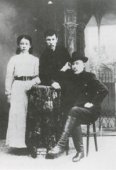 Today is the 141st birthday of Grigoriy Choros-Gurkin (1870-1937), a famous Siberian painter, a student of Ivan Shishkin.
Today is the 141st birthday of Grigoriy Choros-Gurkin (1870-1937), a famous Siberian painter, a student of Ivan Shishkin.
From 1921 to 1952, Choros-Gurkin lived and worked in Tuva. Today his works, including the ones made in Tuva, hang in museums of Siberia, the State Russian Museum,(Sankt-Peterburg), in France and in Mongolia.
In 1937, as a supposed organizer of uprising activities (in favor of Japan), he was sentenced to death by shooting. Grigoriy Choros-Gurkin combined the traditions of realistic painting of the 19th century with symbolistic influences. By crating epic paintings permeated by ancient mythological associations of his country, he became a powerful influence on the local culture. During the years 1917-1919, Choros-Gurkin was the head of the local Duma, which attempted to initiate self-government and to secure national equality for Altaians.
Escaping from arrest, Choros-Gurkin left Russia. It is known that he was taken captive in the well-known battle of Kochetov's partisan army with the White soldiers of Andrei Bakich in Tuva under the Shandyg cliff. As the Red Commander Sergei Kochetov remembered: "A tall, rough-faced old officer without epaulettes, who looked like a Khakass came up to me, requesting medical help if such was available. I told him that he would be taken to Ust-Elegest with our wounded, where our hospital was. The name Georgiy Choros-Gurkin simply did not mean anything to me at the time. According to his documents, he was an adviser in national matters with Bakich's headquarters. He did not present his weapon, possibly he did not have one. So I let him go."
The artist settled in Tuva for four years. The republic in the center of Asia remained in his series of paintings "Lakes of Tuva" and "Yenisei". In 1926 the painter created a series of paintings for the Leningrad Geological Museum of AN USSR "Geological composition of Tannu-Tuva mountains".
On return to his native country, Grigoriy Choros-Gurkin took active part in local cultural life, becoming a member of the "New Siberia" association. He was also an active writer-ethnographer. In 1937 he was shot as an "enemy of the people".
In 1956, the artist was rehabilitated.
Documents from the "shooting" 30's stated: "It is obvious that he became a Japanese spy already in 1901, when he came to Peterburg to enter the Academy of Arts. He was recruited by G. N. Potanin who was post-mortem recognized by the brave Chekists as a Japanese intelligence agent. All of Gurkin's work in the capacity of the chairman of the Gornaya Duma, later of the Karakorum-Altai administration, took place under the leadership of Japanese intelligence to further Japanese interests. The main reason for his return to Tuva was to continue his counter-revolutionary activities, striving to overthrow the Soviet government. Towards this goal, he organized the Block of Altai Nationalists, which together with counter-revolutionary nationalistic organizations of Khakassia, Tuva, and Gornaya Shoria, aimed to establish a bourgeois state within the borders of the old Dzungarian Khanate, under Japanese protectorate."
Choros-Gurkin became famous as an educator, thinker and enlightener. His experience in national and territorial composition of Gornyi Altai was utilized by the Soviet government in establishing the Oirat 9Gorno-Altaisk) Autonomous Region (from 1922), which later became reorganized into Republic Altai.

